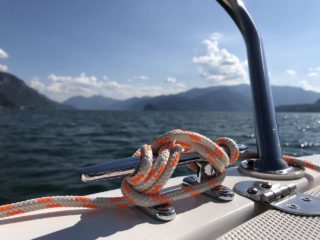Share the post "What is a Boat Transom? Your Ultimate Guide!"
Let’s continue with the world of sailboat anatomy, looking at the often overlooked but important transom. We investigate the various types of transoms, their placement, and their composition, and shed light on the difference between a stern and a transom. So, let’s set sail and find out about the boat transom!
What is a boat transom?
Let’s begin our journey by understanding what a boat transom is. Tucked away at the stern, the transom is more than just a part of the boat’s anatomy. It acts as protection against the water’s resistance, shaping the boat’s wake, and serving as an essential platform for various components and activities.
Which type of boats have a transom?
The transom is a fundamental component of boat design, and most boats will have one. You’ll find transoms on small fishing boats, where they often provide a mounting point for outboard engines. You’ll also see them on larger recreational boats like yachts and sailboats, where they might house additional features such as swim platforms or diving boards. Commercial vessels like ferries or cruise ships have them too, though they’re often hidden under various structures or equipment. From dinghies to ocean liners, the transom is a common feature across a broad spectrum of boat types.
Where is the boat transom located?
The transom is relatively easy to spot! Picture the stern (rear end) of your boat. That flat or curved surface that takes on the water’s resistance? That’s the transom! It’s essentially the backbone of your boat, giving it strength and rigidity while helping shape the wake. Many boat owners put the name of their boat on the transom, which is another way to locate where it is!

What is a boat transom made of?
A transom is as good as the material it’s made of. Traditionally, it is made from materials such as plywood, fibreglass, or aluminium.
Plywood
Plywood is often the go-to choice for boat builders due to its strength and affordability.
Fibreglass
Fibreglass is lightweight yet durable, and resistant to water damage, which is a big tick for anything boat-related!
Aluminium
Aluminium is tough and resistant to corrosion, offering a long-lasting solution for transoms.
What are the different types of boat transoms?
Moving on to the types of boat transoms, we look at three main types: full transom, reverse transom, and cutaway transom. Whether you’re prioritising space, style, or speed, understanding these different transom types will help you make a more informed choice when picking your next vessel with Click&Boat.
Full Transom
As the name suggests, full transoms span the entire width of the boat, giving it maximum strength and space. You can easily spot these on fishing boats or cruising sailboats.
Reverse Transom
Next up is the reverse transom. It tilts backward, creating an illusion of a longer waterline and offering more space on the deck.
Cutaway Transom
The cutaway transom, as the name suggests, has a chunk ‘cut away’, creating a ‘V’ shape at the stern. This type enhances performance by reducing drag and adds a sleek look to the boat.
What is a boat transom used for?
There are various uses for the transom, and you would be surprised how important it is! Here are a few:
Protect and support the back of the boat
Not only does it add protection to the back of the boat, it also acts as a barrier to prevent water from entering.
Supports the outboard motor
Some recreational boats require a motor that needs to be attached to the back of the boat. The transom provides a sturdy place for the motor to attach to.
Provides a space for accessories
In addition to mounting the motor, the transom is used to mount boating equipment such as ladders or a swing platform.

What is the Difference Between a Stern and a Transom?
The terms stern and transom might be used interchangeably, but it’s important to know that they are not actually the same thing. The stern refers to the whole back end of the boat, while the transom is specifically the flat (or sometimes curved) surface on the stern. In simple terms, the transom is a part of the stern.

Transom maintenance and safety tips
Like any part of the hull, the transom needs regular checks. Look for cracks in the gelcoat, soft spots in wooden cores or loose fittings around ladders and outboard brackets. Any movement here can let water seep in and weaken the structure over time. Rinse the area with fresh water after each trip, especially on saltwater boats. If you see staining, water bubbles or feel flexing when you push the transom, have a professional inspect it. Good maintenance will keep your transom strong and your boat safer on the water.
As we’ve explored in this blog post, the transom serves multiple purposes, from providing protection against water resistance to acting as a platform for various components. Whether you’re on a small fishing boat, a luxurious yacht, or a commercial vessel, chances are you’ll find a transom that plays a vital role in the design and functionality of the boat. We hope that understanding the different types of transoms means next time you are booking your boat, you will be able to spot one!
FAQ
The transom closes the full at the stern, supports the structure and provides a mounting point for engines and gear.
Most motorboats and many sailboats have a transom. Very traditional designs with a pointed stern may not.
Signs of damage include cracks, soft or spongy areas, water stains, or fittings that move when pushed by hand.
Yes, but it can be a big job. Damaged core material must be removed and replaced by a qualified boat builder.
Give it a quick visual check before every season and a closer inspection at least once a year.











